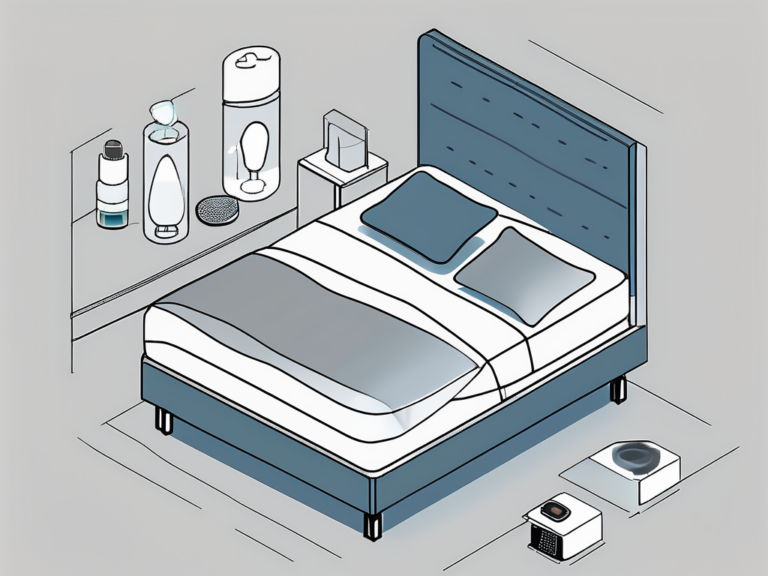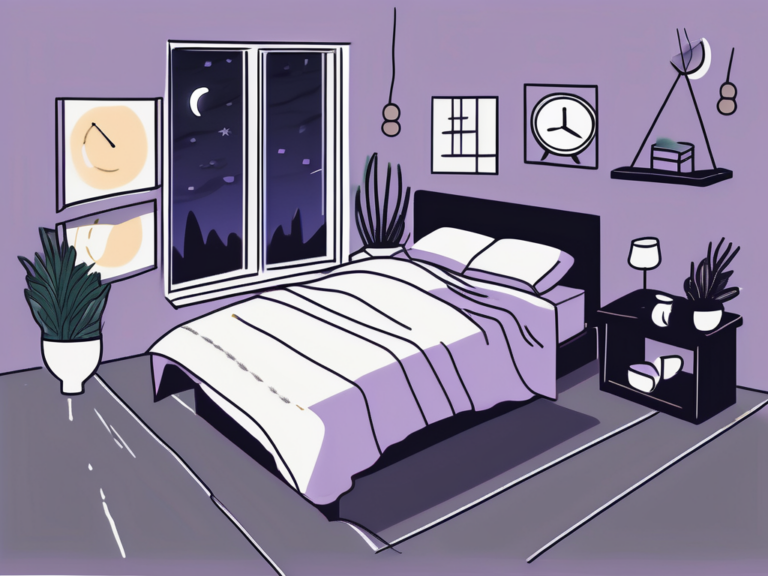The Brain Stimulator and Sleeping
Have you ever struggled to get a good night’s sleep? If so, you’re not alone. Sleep disorders and poor sleep quality affect millions of people worldwide. But what if there was a way to enhance your sleep naturally, without relying on medication or other traditional methods? Enter brain stimulation, a fascinating field that explores the connection between our brains and sleep. In this article, we’ll delve into the science behind brain stimulation and its impact on sleep, explore different types of brain stimulators, examine the benefits and potential risks, and take a peek into the future of this exciting field.
Understanding the Connection Between Brain Stimulation and Sleep
Sleep is a complex process that involves various neural networks and chemicals in our brains. It plays a crucial role in our overall well-being, affecting our physical health, cognitive function, and emotional balance. Understanding how brain stimulation affects sleep requires diving into the intricate workings of our brain and the science behind it.
The Science Behind Brain Stimulation
Brain stimulation, also known as neuromodulation, involves the use of electrical currents or magnetic fields to influence the activity of specific brain regions. This technique has been widely studied and used in various fields, including neuroscience and psychiatry. When it comes to sleep, researchers have discovered that certain brain regions play a vital role in regulating sleep-wake cycles and sleep quality.
One such region is the hypothalamus, which acts as the master regulator of sleep. It releases hormones that control our sleep-wake cycles, helping us transition between different stages of sleep. Another important region is the prefrontal cortex, responsible for executive functions such as decision-making and attention. Disruptions in these brain regions can lead to sleep disorders, such as insomnia or sleep apnea.
Studies have shown that stimulating these regions can enhance sleep by promoting healthy sleep patterns and reducing sleep disturbances. The precise mechanisms behind this phenomenon are still being explored, but it’s believed that brain stimulation can affect neurotransmitters and neural pathways involved in sleep regulation.
How Sleep is Affected by Brain Stimulation
So how exactly does brain stimulation impact sleep? Well, it depends on the type of brain stimulator used. There are two main categories: non-invasive and invasive brain stimulators. Let’s take a closer look at each.
Non-invasive brain stimulators, such as transcranial magnetic stimulation (TMS) or transcranial direct current stimulation (tDCS), work by delivering electrical currents or magnetic fields to the scalp. These currents or fields then penetrate the skull and reach the targeted brain regions. By modulating the activity of these regions, non-invasive brain stimulation can help regulate sleep-wake cycles and improve sleep quality.
Invasive brain stimulators, on the other hand, involve the implantation of electrodes directly into the brain. Deep brain stimulation (DBS) is one such technique, commonly used for treating movement disorders like Parkinson’s disease. In recent years, researchers have also explored the potential of DBS for sleep disorders. By stimulating specific brain regions with implanted electrodes, DBS can help regulate abnormal brain activity and promote healthier sleep patterns.
Types of Brain Stimulators and Their Impact on Sleep
Non-Invasive Brain Stimulators
Non-invasive brain stimulators, such as transcranial magnetic stimulation (TMS) and transcranial electrical stimulation (tES), are external devices that deliver electromagnetic currents or electrical pulses to specific areas of the brain. These techniques are considered safe and painless, making them attractive options for enhancing sleep.
Research has shown that non-invasive brain stimulation methods can improve sleep quality by increasing slow-wave activity, which is associated with deep, restorative sleep. They can also help regulate circadian rhythms, which play a crucial role in sleep-wake cycles. Additionally, these techniques may have potential applications in treating sleep disorders like insomnia.
Let’s delve deeper into the fascinating world of non-invasive brain stimulation. Imagine lying comfortably in a serene room, surrounded by state-of-the-art technology. As the gentle hum of the brain stimulator fills the air, you can feel the anticipation building. The device is carefully positioned on your scalp, targeting the precise region of your brain responsible for sleep regulation. With each pulse of electromagnetic energy or electrical current, a cascade of neural activity is set in motion, gently coaxing your brain into a state of deep relaxation.
But what exactly happens within your brain during this process? Let’s take a closer look. As the electromagnetic currents or electrical pulses reach their intended destination, they stimulate the neurons in that area, triggering a series of complex reactions. These reactions lead to an increase in slow-wave activity, promoting the generation of those coveted delta waves that are characteristic of deep sleep. Your brain becomes a symphony of synchronized neural oscillations, harmoniously lulling you into a state of profound restfulness.
Invasive Brain Stimulators
Invasive brain stimulators, on the other hand, involve the implantation of electrodes directly into the brain. Deep brain stimulation (DBS) is a well-known example of invasive brain stimulation and is commonly used to treat movement disorders such as Parkinson’s disease. While still in the early stages of research, invasive brain stimulation shows promise in modulating sleep-related brain regions.
However, it’s essential to note that invasive brain stimulation is a highly specialized procedure and is typically reserved for severe cases or when other treatments have failed. The risks and potential side effects of this procedure should be thoroughly evaluated and discussed with medical professionals.
Imagine a surgical suite, where skilled neurosurgeons meticulously navigate the intricate pathways of the brain. With utmost precision, they implant tiny electrodes into specific regions, targeting the neural circuits responsible for sleep regulation. These electrodes, connected to a small device implanted under the skin, emit carefully controlled electrical impulses. As these impulses travel through the brain, they modulate the activity of sleep-related brain regions, fine-tuning the delicate balance of your sleep-wake cycle.
While invasive brain stimulation holds great promise, it is crucial to understand that this procedure is not without risks. The delicate nature of the brain demands the utmost care and expertise. Potential side effects, such as infection, bleeding, or changes in mood or cognition, must be carefully considered. The decision to undergo invasive brain stimulation should always be made in consultation with a team of medical professionals who can provide comprehensive guidance and support.
Benefits of Using Brain Stimulators for Sleep
Improved Sleep Quality
One of the most significant benefits of using brain stimulators for sleep is improved sleep quality. By targeting specific brain areas involved in sleep regulation, these devices can help promote deeper, more restful sleep. This can lead to increased daytime alertness, improved mood, and better overall cognitive performance.
Furthermore, enhanced sleep quality can have a ripple effect on various aspects of our lives. Studies have shown that getting adequate, high-quality sleep can boost immune function, improve cardiovascular health, and even aid in weight management. Therefore, investing in technologies like brain stimulators that enhance sleep quality can have far-reaching benefits beyond just feeling well-rested.
Reduced Sleep Disorders
Sleep disorders can have a profound impact on our health and well-being. Brain stimulators offer a potential solution for individuals struggling with conditions like insomnia, sleep apnea, and restless leg syndrome. By modulating the brain’s activity, these devices aim to alleviate symptoms and improve sleep-related outcomes.
Moreover, the use of brain stimulators in addressing sleep disorders underscores the growing recognition of the integral role that brain activity plays in regulating sleep patterns. By leveraging cutting-edge technology to fine-tune neural circuits involved in sleep, individuals have the opportunity to experience relief from debilitating sleep disorders and enjoy a higher quality of life.
It’s important to note, though, that brain stimulators should not replace traditional therapies for sleep disorders. They should be seen as complementary approaches that can enhance existing treatments.
Potential Risks and Side Effects of Brain Stimulation
Short-Term Side Effects
While brain stimulation techniques are generally considered safe, there can be some short-term side effects. These can include mild headaches, scalp discomfort, and tingling sensations during or after stimulation. However, these side effects are typically transient and subside quickly.
It is important to note that individual responses to brain stimulation can vary. Some individuals may experience no side effects at all, while others may have a more pronounced reaction. Monitoring these effects and communicating with healthcare providers can help manage any discomfort that may arise.
Long-Term Side Effects
When it comes to long-term side effects, the research is still evolving. Since brain stimulation is a relatively new field, long-term effects are not yet fully understood. Extensive research and ongoing studies are crucial to ensure the safety and effectiveness of these techniques over extended periods. It’s essential to consider the potential risks before undergoing any brain stimulation procedures.
Researchers are actively investigating the possibility of rare but serious long-term side effects associated with brain stimulation. These may include changes in cognitive function, mood alterations, or potential impacts on brain tissue. Understanding these risks is vital for both healthcare providers and individuals considering brain stimulation as a treatment option.
The Future of Brain Stimulation in Sleep Science
Ongoing Research in Brain Stimulation
The field of brain stimulation is rapidly evolving, and ongoing research continues to uncover new insights into its potential applications and mechanisms. Scientists are exploring innovative ways to refine existing techniques and develop novel approaches to enhance sleep quality.
By deepening our understanding of the brain’s intricate workings and the relationship between brain stimulation and sleep, researchers hope to further optimize these techniques and expand their applications in the future.
One fascinating area of exploration in brain stimulation is the use of non-invasive techniques such as transcranial magnetic stimulation (TMS) and transcranial direct current stimulation (tDCS) to modulate brain activity during sleep. These methods hold promise for enhancing memory consolidation, promoting deep sleep, and even potentially treating sleep disorders like insomnia and sleep apnea.
Potential Innovations in Sleep Technology
In addition to brain stimulation, sleep technology as a whole is continuously advancing. From wearable devices that track sleep patterns to smart mattresses that adjust to our sleep needs, there’s a wealth of possibilities. The integration of brain stimulation techniques with these emerging technologies holds great potential for personalized, effective sleep interventions.
Moreover, the future of sleep technology may also involve the development of advanced artificial intelligence algorithms that can analyze sleep data in real-time and provide personalized recommendations for improving sleep quality. Imagine a world where your smart sleep device not only tracks your sleep stages but also adjusts environmental factors like room temperature and lighting to create the optimal sleep environment for you.
However, it’s crucial to approach these innovations with caution. While they have the potential to revolutionize sleep science, it’s important to prioritize safety, thorough research, and expert guidance to ensure their optimal and responsible use.
In Conclusion
Brain stimulation offers a fascinating glimpse into the future of sleep science, with its potential to enhance sleep quality and alleviate sleep disorders. While the field is still in its early stages, it holds tremendous promise for those seeking natural and non-invasive solutions to improve their sleep. As research continues and technology advances, we can look forward to a future where brain stimulation plays a significant role in promoting healthier, more restful nights of sleep. So, keep your eyes open, and your mind stimulated!






